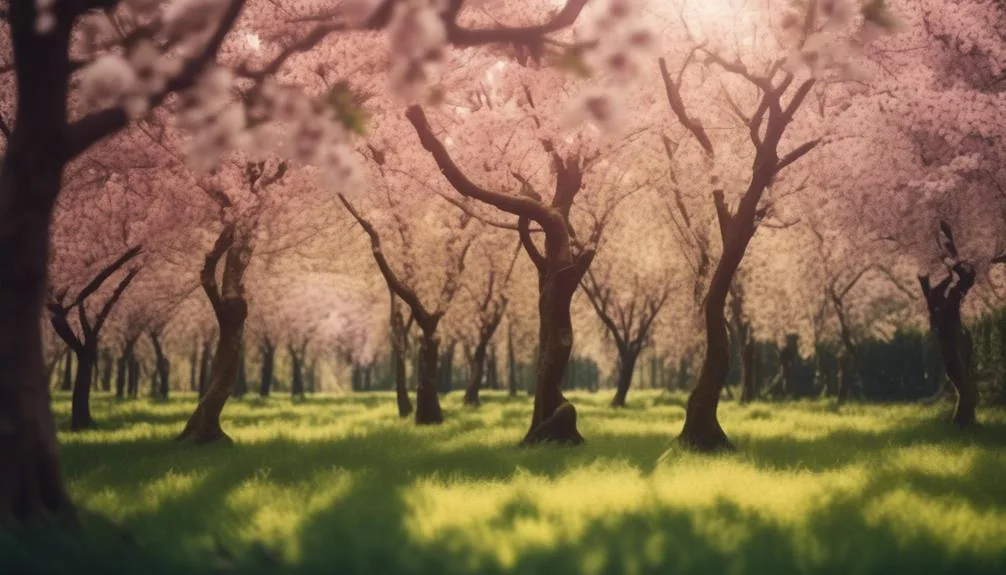Wondering if cherry trees can grow alongside other trees? It's not a simple yes or no.
While cherry trees are admired for their beautiful blossoms, their growth habits and needs can make it challenging to plant them near other trees.
But with the right approach, it's possible to create a balanced environment where cherry trees and other species can coexist.
Let's explore the factors involved in considering whether cherry trees can thrive next to other trees.
Cherry Trees and Soil Conditions
When planting cherry trees, it's crucial to ensure that the soil conditions are optimal for their growth and productivity. Soil acidity plays a significant role in the success of cherry trees. They thrive in slightly acidic soil with a pH range of 6.0 to 6.8. Testing the soil and amending it if necessary can greatly enhance the chances of successful cherry tree growth.
Another factor to consider is root competition. When cherry trees are planted next to other trees, there can be competition for nutrients and water. It's important to provide adequate space and ensure that the cherry tree's roots aren't encroached upon by other trees.
Compatibility With Other Tree Species
To ensure the successful growth of your cherry trees next to other tree species, it's essential to consider their compatibility and potential impact on soil conditions and root competition. Tree interactions and diversity play a crucial role in determining whether cherry trees can thrive alongside other species. Here are some key points to consider:
- Root Competition: Different tree species have varying root systems, and some may compete more aggressively for water and nutrients, affecting cherry tree growth.
- Soil pH and Nutrient Requirements: Tree species have different soil pH and nutrient needs. Ensure that the soil can meet the requirements of all tree species involved.
- Canopy Interference: Consider how the canopy of other trees may shade or obstruct sunlight for the cherry trees, affecting their growth and fruit production.
- Allelopathy: Some trees release chemicals that can inhibit the growth of other species. Research potential allelopathic effects between cherry trees and other species.
Understanding these factors can help you create a harmonious environment for your cherry trees and other tree species.
Considerations for Planting Cherry Trees
Considering the ideal soil conditions and suitable companion plants is essential for successful cherry tree planting. When selecting a location, ensure the soil is well-draining with a pH of 6.0-6.8. Cherry trees also benefit from being planted near pollination partners, such as other cherry tree varieties or compatible fruit trees like pear or plum. Below, find a table summarizing key considerations for planting cherry trees.
| Consideration | Description |
|---|---|
| Soil Conditions | Well-draining, pH 6.0-6.8 |
| Companion Plants | Pollination partners like other cherry varieties |
| Pruning Techniques | Regular pruning to maintain tree health and shape |
Potential Issues With Proximity to Other Trees
Planting cherry trees in close proximity to other trees can lead to potential issues that may affect the growth and health of the cherry trees. When considering the proximity of other trees to cherry trees, it's important to be aware of the following:
- Root Competition: The roots of different trees will compete for water and nutrients in the soil, potentially stunting the growth of the cherry trees.
- Tree Spacing: Close proximity to other trees can lead to overcrowding, limiting sunlight and air circulation, which are essential for the optimal growth of cherry trees.
- Disease Spread: Proximity to other trees can increase the risk of disease transmission, as pathogens can easily spread between trees.
- Nutrient Depletion: In close proximity, trees can deplete the soil of essential nutrients, impacting the overall health of cherry trees.
Ensuring adequate spacing and managing root competition are crucial for the successful growth of cherry trees.
Tips for Successful Cherry Tree Growth
For successful cherry tree growth, prioritize adequate sunlight and proper spacing to ensure optimal development.
Cherry trees thrive in full sunlight, so choose a location with at least 6-8 hours of direct sunlight daily.
Proper spacing is crucial for cherry trees to receive ample nutrients and airflow. When planting, ensure a distance of 15-20 feet between trees to prevent overcrowding and competition for resources.
Additionally, employing appropriate pruning techniques is essential for cherry tree health. Regularly remove dead or diseased branches to promote new growth and prevent the spread of infections.
Moreover, selecting suitable pollination partners can significantly impact cherry tree fruit production. Consider planting compatible varieties nearby to enhance pollination and increase the yield of delicious cherries in your garden.
Conclusion
In the right conditions and with care, cherry trees can indeed grow alongside other trees, adding diversity and beauty to your garden.
Consider the planting location and potential issues, but with proper attention, you can create a thriving landscape.
Happy gardening!
Mark Hoffman is a dedicated arborist and tree care specialist with over a decade of experience. His love for trees began when he visited Yosemite National Park as a teenager and was awestruck by the giant sequoias. Mark pursued his passion by studying forestry at Michigan Technological University, where he earned a Bachelor of Science degree.
Since then, he has worked tirelessly in the field of arboriculture, helping to preserve and protect trees in his community. His expertise and dedication have made him a respected leader in the industry and a valuable resource for anyone seeking advice on tree care.
